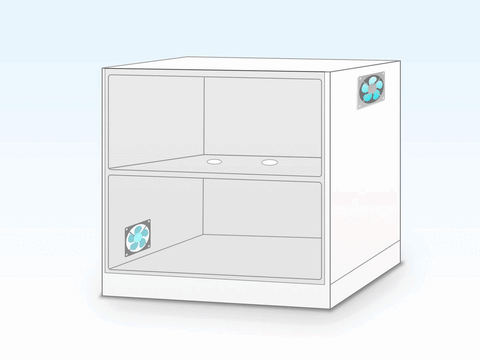Airflow is important to keep your temperatures within safe ranges and your electronics cabinets running. Choosing the right size of cooling fan and Having done this for over twenty years, we have gained useful insight that makes it more straightforward to determine what the fan and airflow will be on your specific setup. To help you cool optimally, we will also supply some useful rules of thumb and other considerations.
How Much Airflow Do I Need? Understanding CFM
It is measured in cubic feet per minute (CFM). This is the amount of air a fan can move in one minute. For electronic cabinets, it is important to have enough airflow since overheating may cause electronic components to fail or work poorly early. Thus, proper airflow is not only cooling but long-term equipment reliability and efficiency.
The Electronics Cabinet Rule of Thumb Formula
One simple way to calculate how much CFM should be present in an electronics cabinet is to use an easy formula that we have depended on for decades:
Length x Width x Height x 4 = Required CFM
This will give you a ball park estimate of air flow using the dimensions of your cabinet. Using a cabinet with 2 feet of length, 1.5 in width, and 1.5 in height, this would be:
2 * 1.5 * 1.5 * 4 = 18 CFM
This is more an estimate than a mathematical formula, however. There are lots of other factors that’ll determine your actual airflow requirements, including the temperature external to the cabinet, number of electronic devices within it, and design of ventilation inside the cabinet. The hotter the environment outside the cabinet, the more air this cabinet will need. If many high-processing electronics are crammed into a small area, it will require still more. If your cabinet is in a naturally cool environment, it will demand less.
Fan Size Matters: When Bigger is Better
It’s not just to fill the space, because often the large fan offers the same airflow as what the small one would have had in store but much less in speed and consequently very minimal noise. Decibel levels indicate that the greater the size of the fan, the higher the surface area. It then is possible to achieve high air flow with minimal RPM hence noise going down to minimal.
In fact, we found most applications require fans to have a diameter of around 120mm (4.7 inches). Not only is the balance between airflow and noise excellent, but such sizes also fit standard cabinets best. For those with very cramped spaces, we have kits available in 80mm, 92mm, and even 140mm for any cabinet dimension and cooling application.
The Downsides to Bigger DC Fans
It would be a natural instinct to go with the largest fan available; however, it’s critical to note some potential disadvantages of oversized fans in DC applications. At higher RPMs, larger DC fans sometimes lose reliability and static pressure. This reduction in static pressure means the fan can’t push air very well through filters or small cabinet openings, which has a negative effect on cooling performance. That’s why we’d often recommend a 120mm fan since it so often lands at that sweet spot for reliability, airflow, and noise.
Tips to Maximize Airflow in Cabinets Holding Electronics
You can choose the fan you want to bring your cabinet to life, but keep in mind the following points as you do:
Optimize to Ambient Temperatures: A cabinet naturally exposed to cooler ambient conditions is going to require a less powerful fan. Fans inside cabinets placed in hot, enclosed environments are likely to require a fan that can move higher CFM values.
High-Processing Devices: Some cabinets generate high heat outputs from more electronics. So, provide the extra flow capacity through adding fans and maintain an optimum temperature without risking.
Evaluation of the Vent Design: A proper cabinet ventilation refers to the possibility of air easy passage. To get fan functionality at optimal level of working, try to establish it in free movement across warm air evacuation and entrance cool air to it.
Selection of Perfect Fan Kit of Your Configuration
With decades of experience, we offer a range of fan kits that are tailored to various cabinet sizes and airflow needs. If your cabinet can fit a 120mm fan, this usually is the best size for balancing airflow and noise. For smaller cabinets, we also provide 80mm and 92mm options. A 140mm fan would be the way to go for larger cabinets or those in hotter environments.
The selection of a fan for your electronics cabinet would not seem a tough issue by the following guidelines, you should obtain effective, reliable cooling. The right ventilation is critical for maintaining your equipment at the optimum and helps keep the components alive longer.
Conclusion
Choosing the right fan for your electronics cabinet is essential for maintaining safe operating temperatures and extending the life of your equipment. By using the rule-of-thumb CFM formula and factoring in cabinet size, ambient temperature, and device load, you can estimate your airflow needs with confidence. Larger fans like our 120mm models often strike the ideal balance between airflow and noise, though we offer a range of fan sizes to accommodate different setups. Ultimately, the right fan ensures that your electronics stay cool, quiet, and reliable, enabling optimal performance over time. With careful consideration, you can set up a cooling solution that fits your cabinet’s unique requirements and keeps your components safe and efficient.
visit- blogwritting


